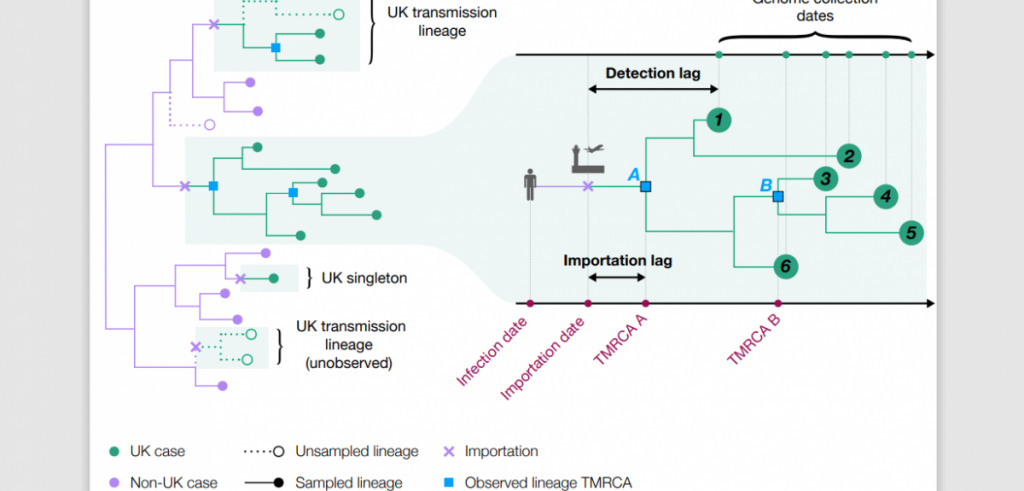A team of scientists, led by researchers from the Universities of Oxford and Edinburgh, has analysed the first wave of the COVID-19 outbreak in the UK and produced the most fine-scaled and comprehensive genomic analysis of transmission of any epidemic to date.


Their analysis draws on >50k virus genome sequences – 26k of which were gathered through the COVID-19 Genomics UK (COG-UK) consortium – offering a never-before-seen level of insight into the origins and behaviour of transmission chains since the start of the pandemic.
The full analysis, published in Science, reveals that the virus was introduced to the UK well over a thousand times in early 2020 and that the rate and source of introduction changed very quickly. During this time the highest number of transmission chains were introduced from Spain (33%), France (29%), and then Italy (12%) – with China accounting for only 0.4% of imports. The study shows how the UK national lockdown affected individual transmission chains.
Corresponding and co-lead author, Professor Oliver Pybus, from Oxford’s Department of Zoology and the Oxford Martin School, said, ‘This study shows that it’s possible to trace individual virus transmission lineages accurately through time and space. Undertaking analyses on a weekly basis means that genomic tracking can become a key component of public health surveillance.’
The results offer a crucial context to what is happening now in the UK’s second wave, and the team has contributed to the identification of the new variant (termed B.1.1.7) growing rapidly in the UK. The scientists say that detailed comparison of the new variant’s behaviour with that of first wave lineages will be crucial to understanding why B.1.1.7 is now spreading so quickly.
Before the March 2020 lockdown, high travel volumes and few restrictions on international arrivals led to the establishment and co-circulation of >1000 identifiable UK transmission lineages, jointly contributing to accelerated epidemic growth that quickly exceeded national contact tracing capacity.
Professor Pybus says, ‘By reconstructing where and when COVID-19 was introduced to the UK we can see that earlier travel and quarantine interventions could have helped to reduce the acceleration and intensity of the UK’s first wave of cases.’
The team expects similar trends occurred in other countries with comparably large epidemics and high international travel volumes.
Whilst the UK national lockdown coincided with limited importation and reduced regional lineage diversity, its impact on lineage extinction was size-dependent, meaning that the largest and most widespread lineages persisted into the summer.
The over-dispersed nature of SARS-CoV-2 transmission is likely to have favoured greater survival of larger, more widespread lineages and faster local elimination of lineages in low prevalence regions, highlighting the importance of rapid or pre-emptive interventions in reducing transmission.
The degree to which the surviving lineages contributed to the UK’s ongoing epidemic in the autumn and winter 2020, including the effect of specific mutations on lineage growth rates, is currently under investigation.
The transmission structure and dynamics measured for the first time in this study provide a new context in which future public health actions at regional, national, and international scales should be planned and evaluated.
Co-lead author, Dr Louis du Plessis, from Oxford’s Department of Zoology, said, ‘Our work offers unparalleled views into what’s happening in an individual epidemic. The UK shares large volumes of virus genetic data publicly on a weekly basis and if you don’t have this level of surveillance you won’t know the real situation of virus evolution and transmission.’
Co-lead author, Verity Hill, PhD researcher, based at Edinburgh University, said, ‘This kind of continuous, nationally coordinated genomic sequencing not only allows the high-resolution analysis we present, but also helps other countries to place their genomic data into context and assists the global pandemic response.’
The ability to ramp up genomic surveillance at a large scale was made possible by the decision to fund the COVID-19 Genomics UK (COG-UK) consortium in April and builds on decades of blue-skies basic research into virus evolution, led by Oxford and Edinburgh universities, which developed the theory leading to scientists having these tools and theory at their disposal.







































